Management Accounting System and Techniques: Detailed Analysis Report
VerifiedAdded on 2020/12/10
|21
|6229
|444
Report
AI Summary
This report provides a comprehensive overview of management accounting systems and techniques. It begins by defining management accounting and its essential requirements, differentiating it from financial accounting, and outlining key components like cost accounting, price optimization, inventory management, and job costing systems. The report then explores various management accounting reporting methods, including cost managerial accounting, budget reports, performance reports, and accounts receivable aging reports. Furthermore, it evaluates the benefits of management accounting systems within an organizational context, detailing how these systems aid in cost control, price optimization, inventory management, and overall financial planning. The report also delves into calculating costs using marginal and absorption costing, accurately applying accounting techniques, and producing financial reports for various business activities. Finally, it examines the advantages and disadvantages of planning tools, their application in budgeting and forecasting, and how management accounting adapts to and solves financial problems, ultimately leading organizations toward sustainable success.
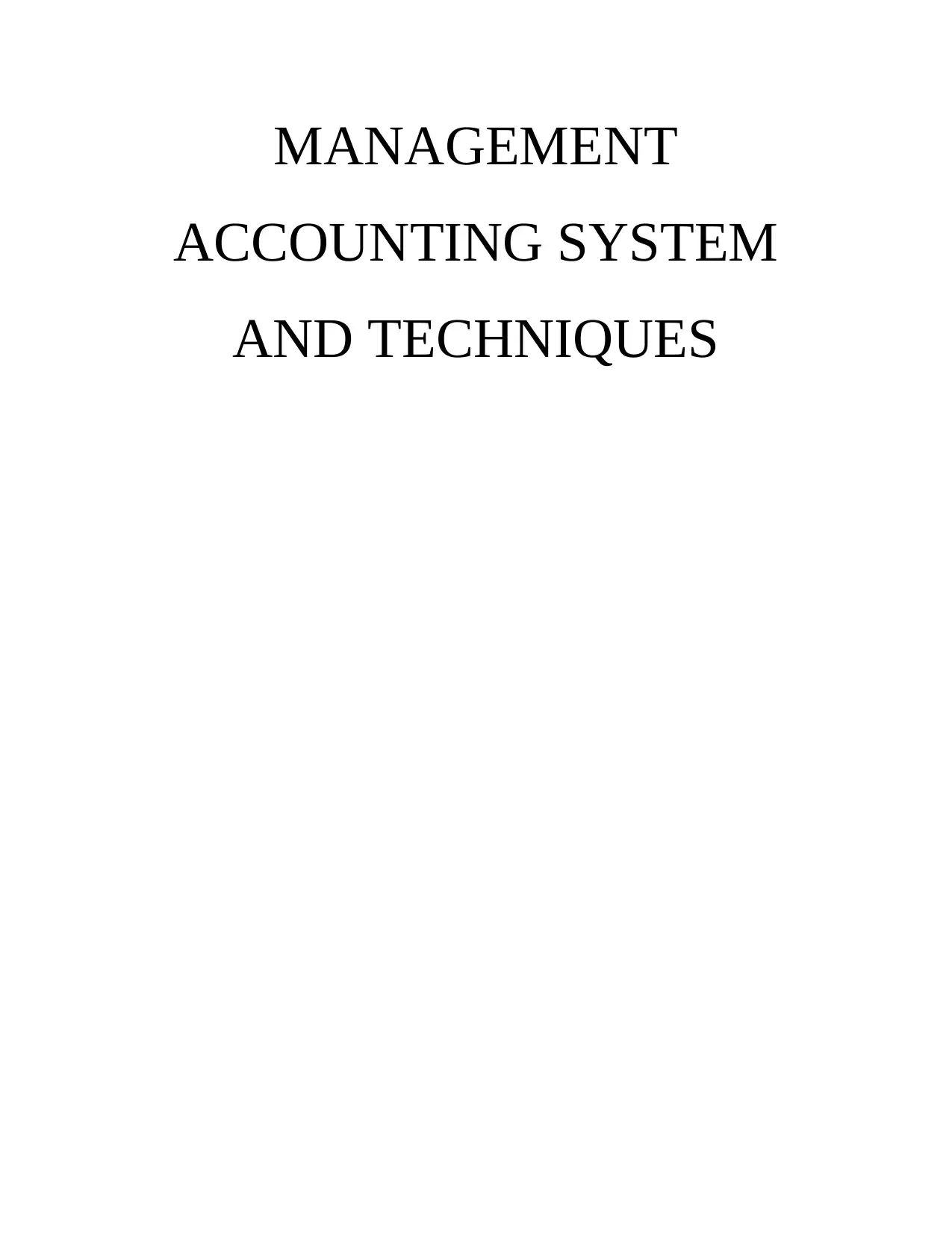
MANAGEMENT
ACCOUNTING SYSTEM
AND TECHNIQUES
ACCOUNTING SYSTEM
AND TECHNIQUES
Paraphrase This Document
Need a fresh take? Get an instant paraphrase of this document with our AI Paraphraser
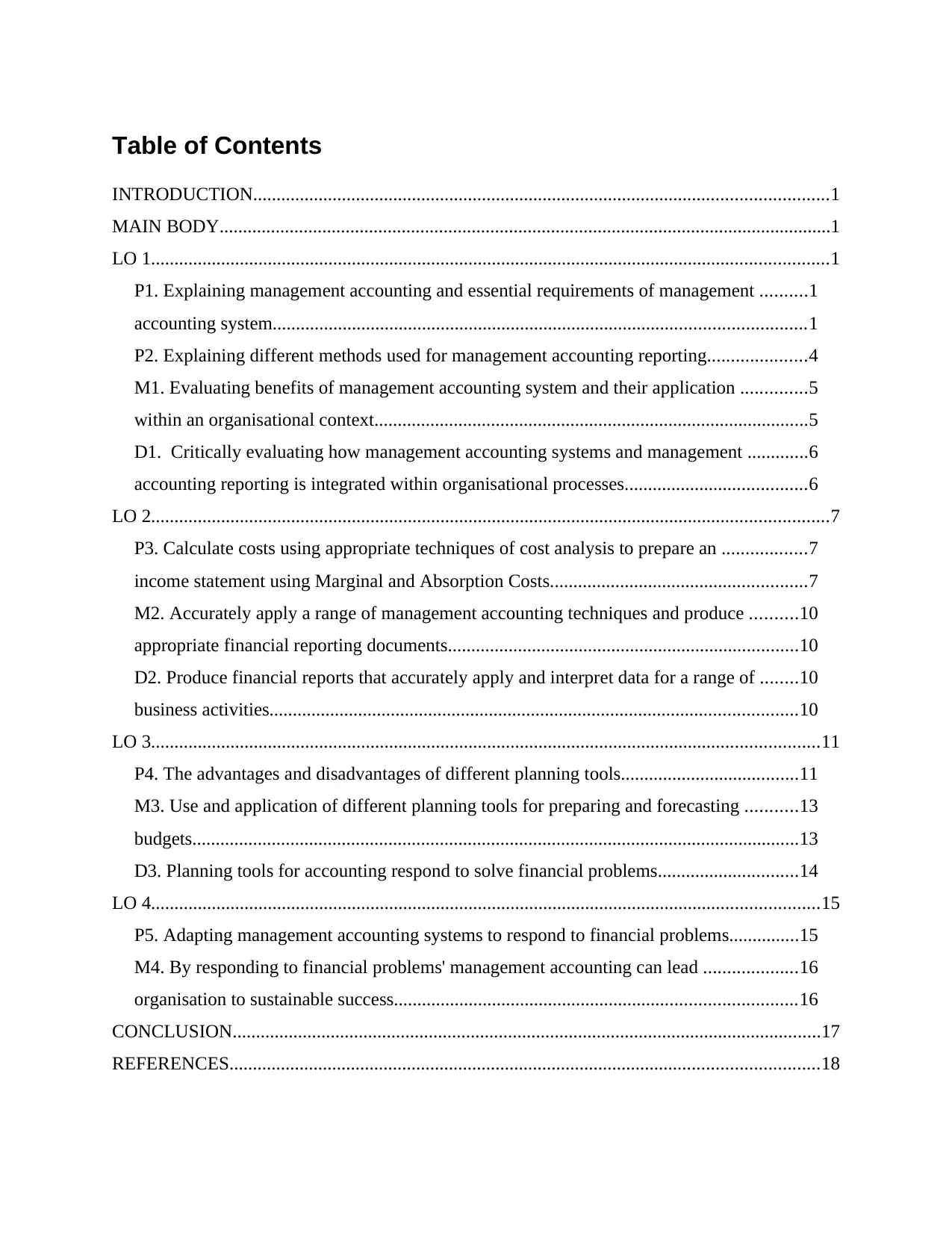
Table of Contents
INTRODUCTION...........................................................................................................................1
MAIN BODY...................................................................................................................................1
LO 1.................................................................................................................................................1
P1. Explaining management accounting and essential requirements of management ..........1
accounting system..................................................................................................................1
P2. Explaining different methods used for management accounting reporting.....................4
M1. Evaluating benefits of management accounting system and their application ..............5
within an organisational context.............................................................................................5
D1. Critically evaluating how management accounting systems and management .............6
accounting reporting is integrated within organisational processes.......................................6
LO 2.................................................................................................................................................7
P3. Calculate costs using appropriate techniques of cost analysis to prepare an ..................7
income statement using Marginal and Absorption Costs.......................................................7
M2. Accurately apply a range of management accounting techniques and produce ..........10
appropriate financial reporting documents...........................................................................10
D2. Produce financial reports that accurately apply and interpret data for a range of ........10
business activities.................................................................................................................10
LO 3...............................................................................................................................................11
P4. The advantages and disadvantages of different planning tools......................................11
M3. Use and application of different planning tools for preparing and forecasting ...........13
budgets..................................................................................................................................13
D3. Planning tools for accounting respond to solve financial problems..............................14
LO 4...............................................................................................................................................15
P5. Adapting management accounting systems to respond to financial problems...............15
M4. By responding to financial problems' management accounting can lead ....................16
organisation to sustainable success......................................................................................16
CONCLUSION..............................................................................................................................17
REFERENCES..............................................................................................................................18
INTRODUCTION...........................................................................................................................1
MAIN BODY...................................................................................................................................1
LO 1.................................................................................................................................................1
P1. Explaining management accounting and essential requirements of management ..........1
accounting system..................................................................................................................1
P2. Explaining different methods used for management accounting reporting.....................4
M1. Evaluating benefits of management accounting system and their application ..............5
within an organisational context.............................................................................................5
D1. Critically evaluating how management accounting systems and management .............6
accounting reporting is integrated within organisational processes.......................................6
LO 2.................................................................................................................................................7
P3. Calculate costs using appropriate techniques of cost analysis to prepare an ..................7
income statement using Marginal and Absorption Costs.......................................................7
M2. Accurately apply a range of management accounting techniques and produce ..........10
appropriate financial reporting documents...........................................................................10
D2. Produce financial reports that accurately apply and interpret data for a range of ........10
business activities.................................................................................................................10
LO 3...............................................................................................................................................11
P4. The advantages and disadvantages of different planning tools......................................11
M3. Use and application of different planning tools for preparing and forecasting ...........13
budgets..................................................................................................................................13
D3. Planning tools for accounting respond to solve financial problems..............................14
LO 4...............................................................................................................................................15
P5. Adapting management accounting systems to respond to financial problems...............15
M4. By responding to financial problems' management accounting can lead ....................16
organisation to sustainable success......................................................................................16
CONCLUSION..............................................................................................................................17
REFERENCES..............................................................................................................................18
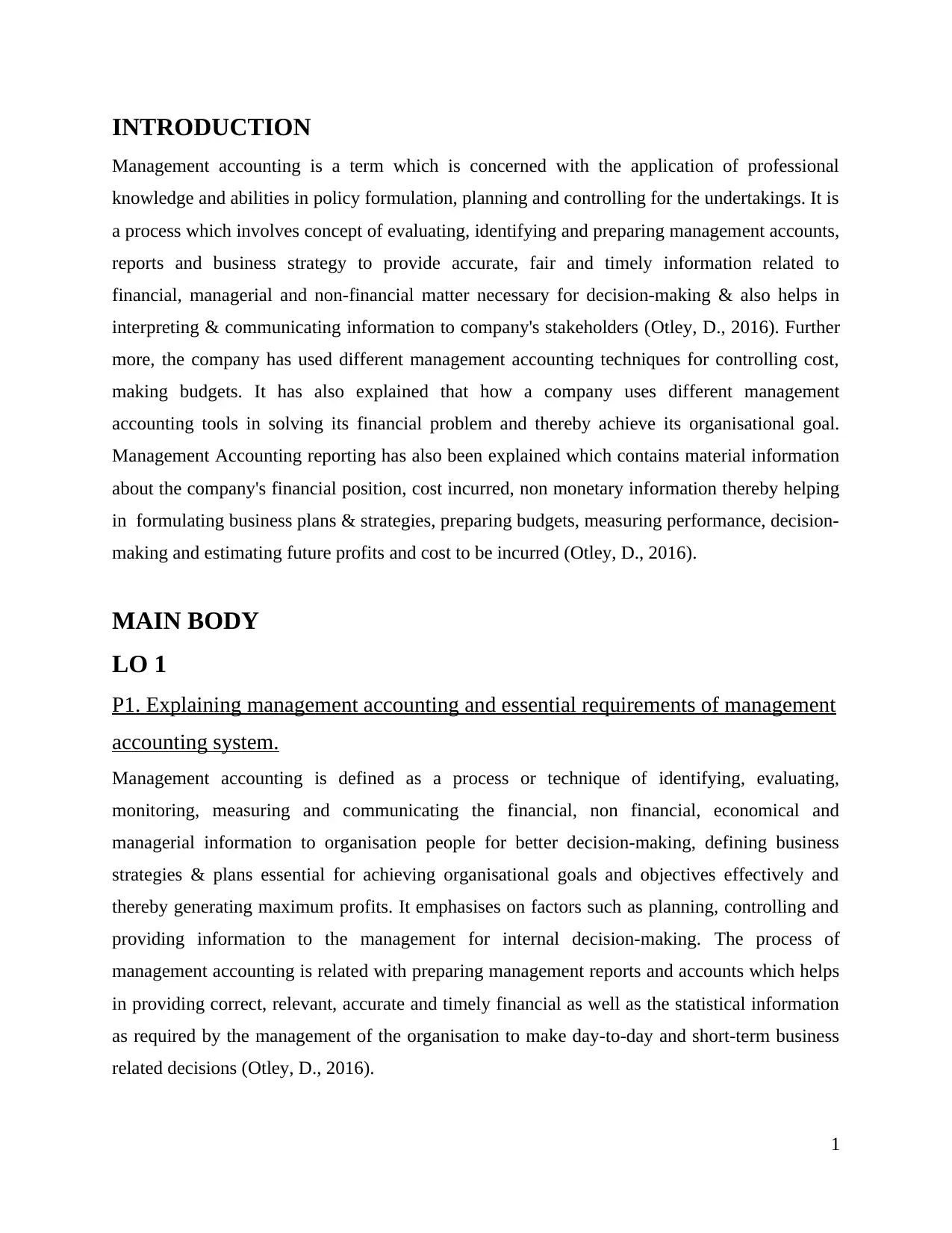
INTRODUCTION
Management accounting is a term which is concerned with the application of professional
knowledge and abilities in policy formulation, planning and controlling for the undertakings. It is
a process which involves concept of evaluating, identifying and preparing management accounts,
reports and business strategy to provide accurate, fair and timely information related to
financial, managerial and non-financial matter necessary for decision-making & also helps in
interpreting & communicating information to company's stakeholders (Otley, D., 2016). Further
more, the company has used different management accounting techniques for controlling cost,
making budgets. It has also explained that how a company uses different management
accounting tools in solving its financial problem and thereby achieve its organisational goal.
Management Accounting reporting has also been explained which contains material information
about the company's financial position, cost incurred, non monetary information thereby helping
in formulating business plans & strategies, preparing budgets, measuring performance, decision-
making and estimating future profits and cost to be incurred (Otley, D., 2016).
MAIN BODY
LO 1
P1. Explaining management accounting and essential requirements of management
accounting system.
Management accounting is defined as a process or technique of identifying, evaluating,
monitoring, measuring and communicating the financial, non financial, economical and
managerial information to organisation people for better decision-making, defining business
strategies & plans essential for achieving organisational goals and objectives effectively and
thereby generating maximum profits. It emphasises on factors such as planning, controlling and
providing information to the management for internal decision-making. The process of
management accounting is related with preparing management reports and accounts which helps
in providing correct, relevant, accurate and timely financial as well as the statistical information
as required by the management of the organisation to make day-to-day and short-term business
related decisions (Otley, D., 2016).
1
Management accounting is a term which is concerned with the application of professional
knowledge and abilities in policy formulation, planning and controlling for the undertakings. It is
a process which involves concept of evaluating, identifying and preparing management accounts,
reports and business strategy to provide accurate, fair and timely information related to
financial, managerial and non-financial matter necessary for decision-making & also helps in
interpreting & communicating information to company's stakeholders (Otley, D., 2016). Further
more, the company has used different management accounting techniques for controlling cost,
making budgets. It has also explained that how a company uses different management
accounting tools in solving its financial problem and thereby achieve its organisational goal.
Management Accounting reporting has also been explained which contains material information
about the company's financial position, cost incurred, non monetary information thereby helping
in formulating business plans & strategies, preparing budgets, measuring performance, decision-
making and estimating future profits and cost to be incurred (Otley, D., 2016).
MAIN BODY
LO 1
P1. Explaining management accounting and essential requirements of management
accounting system.
Management accounting is defined as a process or technique of identifying, evaluating,
monitoring, measuring and communicating the financial, non financial, economical and
managerial information to organisation people for better decision-making, defining business
strategies & plans essential for achieving organisational goals and objectives effectively and
thereby generating maximum profits. It emphasises on factors such as planning, controlling and
providing information to the management for internal decision-making. The process of
management accounting is related with preparing management reports and accounts which helps
in providing correct, relevant, accurate and timely financial as well as the statistical information
as required by the management of the organisation to make day-to-day and short-term business
related decisions (Otley, D., 2016).
1
⊘ This is a preview!⊘
Do you want full access?
Subscribe today to unlock all pages.

Trusted by 1+ million students worldwide
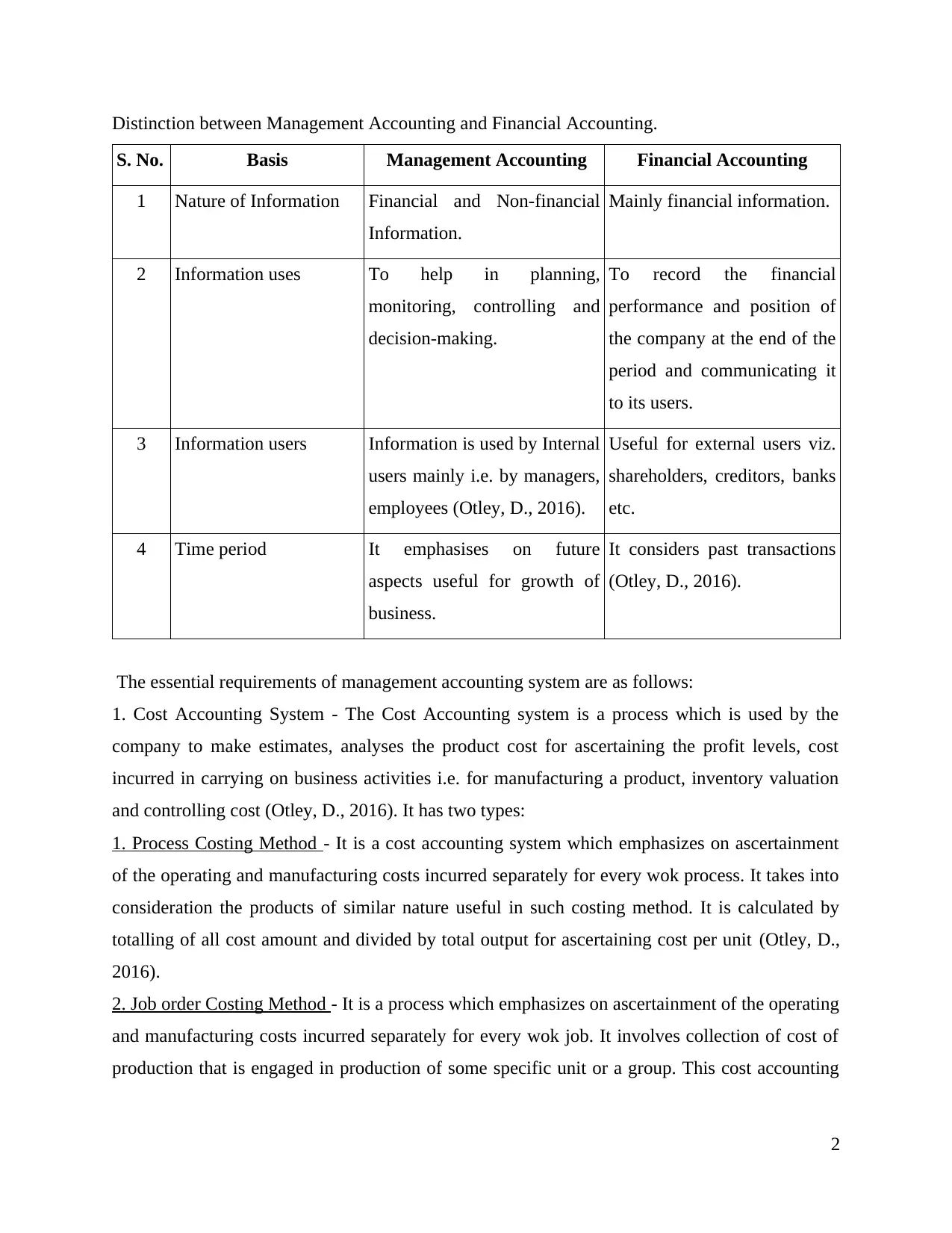
Distinction between Management Accounting and Financial Accounting.
S. No. Basis Management Accounting Financial Accounting
1 Nature of Information Financial and Non-financial
Information.
Mainly financial information.
2 Information uses To help in planning,
monitoring, controlling and
decision-making.
To record the financial
performance and position of
the company at the end of the
period and communicating it
to its users.
3 Information users Information is used by Internal
users mainly i.e. by managers,
employees (Otley, D., 2016).
Useful for external users viz.
shareholders, creditors, banks
etc.
4 Time period It emphasises on future
aspects useful for growth of
business.
It considers past transactions
(Otley, D., 2016).
The essential requirements of management accounting system are as follows:
1. Cost Accounting System - The Cost Accounting system is a process which is used by the
company to make estimates, analyses the product cost for ascertaining the profit levels, cost
incurred in carrying on business activities i.e. for manufacturing a product, inventory valuation
and controlling cost (Otley, D., 2016). It has two types:
1. Process Costing Method - It is a cost accounting system which emphasizes on ascertainment
of the operating and manufacturing costs incurred separately for every wok process. It takes into
consideration the products of similar nature useful in such costing method. It is calculated by
totalling of all cost amount and divided by total output for ascertaining cost per unit (Otley, D.,
2016).
2. Job order Costing Method - It is a process which emphasizes on ascertainment of the operating
and manufacturing costs incurred separately for every wok job. It involves collection of cost of
production that is engaged in production of some specific unit or a group. This cost accounting
2
S. No. Basis Management Accounting Financial Accounting
1 Nature of Information Financial and Non-financial
Information.
Mainly financial information.
2 Information uses To help in planning,
monitoring, controlling and
decision-making.
To record the financial
performance and position of
the company at the end of the
period and communicating it
to its users.
3 Information users Information is used by Internal
users mainly i.e. by managers,
employees (Otley, D., 2016).
Useful for external users viz.
shareholders, creditors, banks
etc.
4 Time period It emphasises on future
aspects useful for growth of
business.
It considers past transactions
(Otley, D., 2016).
The essential requirements of management accounting system are as follows:
1. Cost Accounting System - The Cost Accounting system is a process which is used by the
company to make estimates, analyses the product cost for ascertaining the profit levels, cost
incurred in carrying on business activities i.e. for manufacturing a product, inventory valuation
and controlling cost (Otley, D., 2016). It has two types:
1. Process Costing Method - It is a cost accounting system which emphasizes on ascertainment
of the operating and manufacturing costs incurred separately for every wok process. It takes into
consideration the products of similar nature useful in such costing method. It is calculated by
totalling of all cost amount and divided by total output for ascertaining cost per unit (Otley, D.,
2016).
2. Job order Costing Method - It is a process which emphasizes on ascertainment of the operating
and manufacturing costs incurred separately for every wok job. It involves collection of cost of
production that is engaged in production of some specific unit or a group. This cost accounting
2
Paraphrase This Document
Need a fresh take? Get an instant paraphrase of this document with our AI Paraphraser
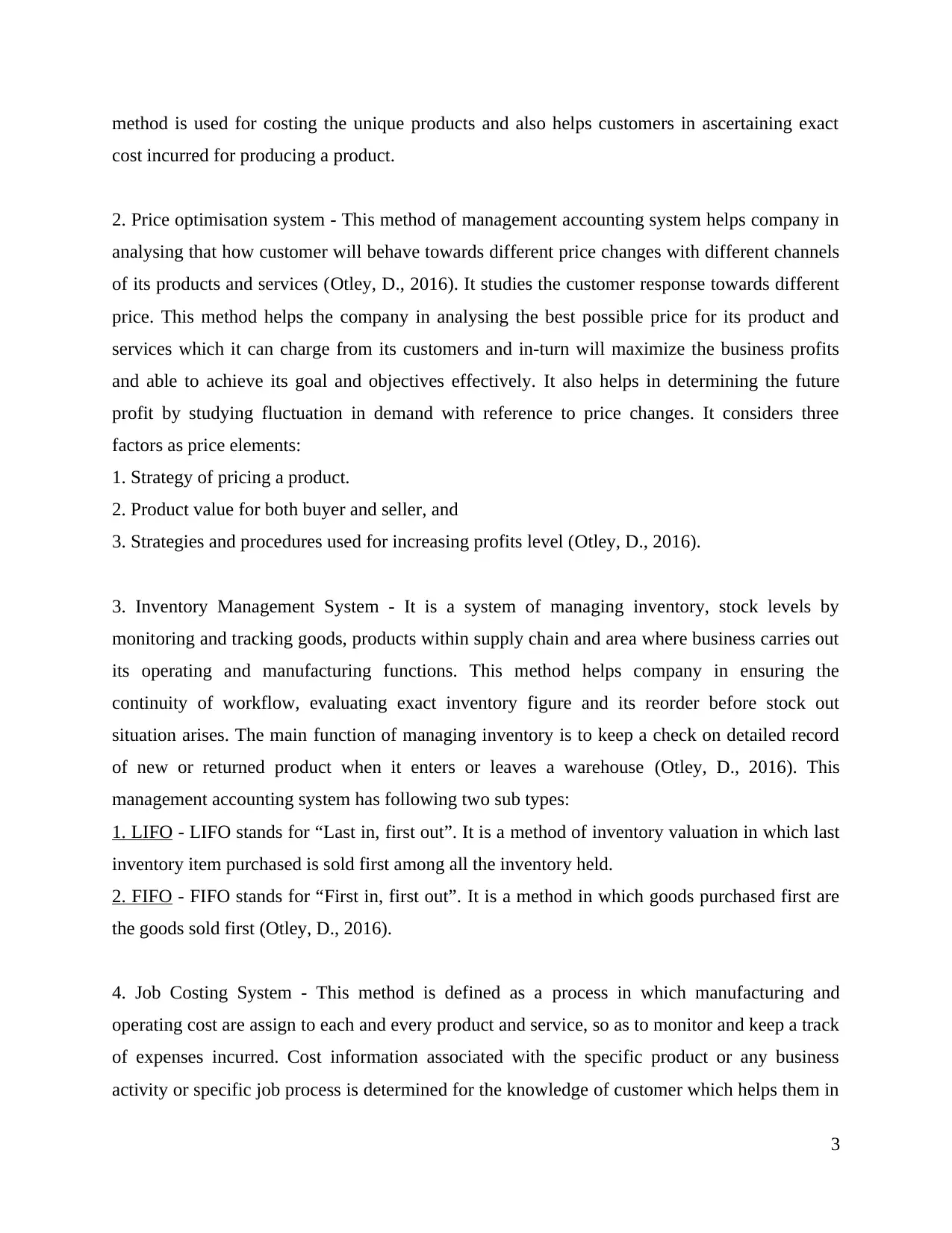
method is used for costing the unique products and also helps customers in ascertaining exact
cost incurred for producing a product.
2. Price optimisation system - This method of management accounting system helps company in
analysing that how customer will behave towards different price changes with different channels
of its products and services (Otley, D., 2016). It studies the customer response towards different
price. This method helps the company in analysing the best possible price for its product and
services which it can charge from its customers and in-turn will maximize the business profits
and able to achieve its goal and objectives effectively. It also helps in determining the future
profit by studying fluctuation in demand with reference to price changes. It considers three
factors as price elements:
1. Strategy of pricing a product.
2. Product value for both buyer and seller, and
3. Strategies and procedures used for increasing profits level (Otley, D., 2016).
3. Inventory Management System - It is a system of managing inventory, stock levels by
monitoring and tracking goods, products within supply chain and area where business carries out
its operating and manufacturing functions. This method helps company in ensuring the
continuity of workflow, evaluating exact inventory figure and its reorder before stock out
situation arises. The main function of managing inventory is to keep a check on detailed record
of new or returned product when it enters or leaves a warehouse (Otley, D., 2016). This
management accounting system has following two sub types:
1. LIFO - LIFO stands for “Last in, first out”. It is a method of inventory valuation in which last
inventory item purchased is sold first among all the inventory held.
2. FIFO - FIFO stands for “First in, first out”. It is a method in which goods purchased first are
the goods sold first (Otley, D., 2016).
4. Job Costing System - This method is defined as a process in which manufacturing and
operating cost are assign to each and every product and service, so as to monitor and keep a track
of expenses incurred. Cost information associated with the specific product or any business
activity or specific job process is determined for the knowledge of customer which helps them in
3
cost incurred for producing a product.
2. Price optimisation system - This method of management accounting system helps company in
analysing that how customer will behave towards different price changes with different channels
of its products and services (Otley, D., 2016). It studies the customer response towards different
price. This method helps the company in analysing the best possible price for its product and
services which it can charge from its customers and in-turn will maximize the business profits
and able to achieve its goal and objectives effectively. It also helps in determining the future
profit by studying fluctuation in demand with reference to price changes. It considers three
factors as price elements:
1. Strategy of pricing a product.
2. Product value for both buyer and seller, and
3. Strategies and procedures used for increasing profits level (Otley, D., 2016).
3. Inventory Management System - It is a system of managing inventory, stock levels by
monitoring and tracking goods, products within supply chain and area where business carries out
its operating and manufacturing functions. This method helps company in ensuring the
continuity of workflow, evaluating exact inventory figure and its reorder before stock out
situation arises. The main function of managing inventory is to keep a check on detailed record
of new or returned product when it enters or leaves a warehouse (Otley, D., 2016). This
management accounting system has following two sub types:
1. LIFO - LIFO stands for “Last in, first out”. It is a method of inventory valuation in which last
inventory item purchased is sold first among all the inventory held.
2. FIFO - FIFO stands for “First in, first out”. It is a method in which goods purchased first are
the goods sold first (Otley, D., 2016).
4. Job Costing System - This method is defined as a process in which manufacturing and
operating cost are assign to each and every product and service, so as to monitor and keep a track
of expenses incurred. Cost information associated with the specific product or any business
activity or specific job process is determined for the knowledge of customer which helps them in
3
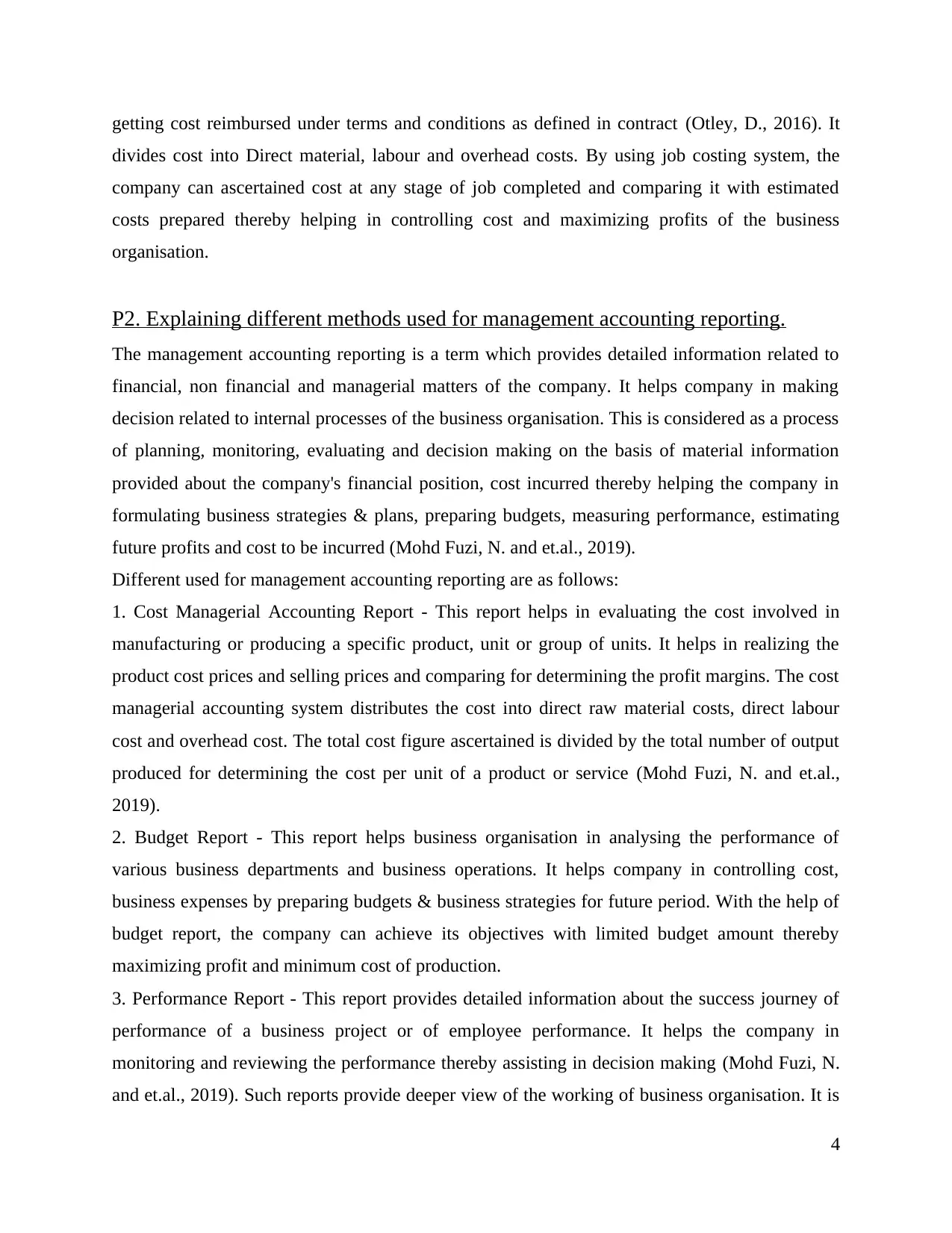
getting cost reimbursed under terms and conditions as defined in contract (Otley, D., 2016). It
divides cost into Direct material, labour and overhead costs. By using job costing system, the
company can ascertained cost at any stage of job completed and comparing it with estimated
costs prepared thereby helping in controlling cost and maximizing profits of the business
organisation.
P2. Explaining different methods used for management accounting reporting.
The management accounting reporting is a term which provides detailed information related to
financial, non financial and managerial matters of the company. It helps company in making
decision related to internal processes of the business organisation. This is considered as a process
of planning, monitoring, evaluating and decision making on the basis of material information
provided about the company's financial position, cost incurred thereby helping the company in
formulating business strategies & plans, preparing budgets, measuring performance, estimating
future profits and cost to be incurred (Mohd Fuzi, N. and et.al., 2019).
Different used for management accounting reporting are as follows:
1. Cost Managerial Accounting Report - This report helps in evaluating the cost involved in
manufacturing or producing a specific product, unit or group of units. It helps in realizing the
product cost prices and selling prices and comparing for determining the profit margins. The cost
managerial accounting system distributes the cost into direct raw material costs, direct labour
cost and overhead cost. The total cost figure ascertained is divided by the total number of output
produced for determining the cost per unit of a product or service (Mohd Fuzi, N. and et.al.,
2019).
2. Budget Report - This report helps business organisation in analysing the performance of
various business departments and business operations. It helps company in controlling cost,
business expenses by preparing budgets & business strategies for future period. With the help of
budget report, the company can achieve its objectives with limited budget amount thereby
maximizing profit and minimum cost of production.
3. Performance Report - This report provides detailed information about the success journey of
performance of a business project or of employee performance. It helps the company in
monitoring and reviewing the performance thereby assisting in decision making (Mohd Fuzi, N.
and et.al., 2019). Such reports provide deeper view of the working of business organisation. It is
4
divides cost into Direct material, labour and overhead costs. By using job costing system, the
company can ascertained cost at any stage of job completed and comparing it with estimated
costs prepared thereby helping in controlling cost and maximizing profits of the business
organisation.
P2. Explaining different methods used for management accounting reporting.
The management accounting reporting is a term which provides detailed information related to
financial, non financial and managerial matters of the company. It helps company in making
decision related to internal processes of the business organisation. This is considered as a process
of planning, monitoring, evaluating and decision making on the basis of material information
provided about the company's financial position, cost incurred thereby helping the company in
formulating business strategies & plans, preparing budgets, measuring performance, estimating
future profits and cost to be incurred (Mohd Fuzi, N. and et.al., 2019).
Different used for management accounting reporting are as follows:
1. Cost Managerial Accounting Report - This report helps in evaluating the cost involved in
manufacturing or producing a specific product, unit or group of units. It helps in realizing the
product cost prices and selling prices and comparing for determining the profit margins. The cost
managerial accounting system distributes the cost into direct raw material costs, direct labour
cost and overhead cost. The total cost figure ascertained is divided by the total number of output
produced for determining the cost per unit of a product or service (Mohd Fuzi, N. and et.al.,
2019).
2. Budget Report - This report helps business organisation in analysing the performance of
various business departments and business operations. It helps company in controlling cost,
business expenses by preparing budgets & business strategies for future period. With the help of
budget report, the company can achieve its objectives with limited budget amount thereby
maximizing profit and minimum cost of production.
3. Performance Report - This report provides detailed information about the success journey of
performance of a business project or of employee performance. It helps the company in
monitoring and reviewing the performance thereby assisting in decision making (Mohd Fuzi, N.
and et.al., 2019). Such reports provide deeper view of the working of business organisation. It is
4
⊘ This is a preview!⊘
Do you want full access?
Subscribe today to unlock all pages.

Trusted by 1+ million students worldwide

important for every company to monitor and keep a track of its strategy & policy developed for
attainment of mission. It is a budget which compares actual and budgeted amounts of cost to be
controlled for a business organisation.
4. Accounts Receivable Aging Reports - The report of Accounts Receivable Aging takes into
consideration the importance of accounts receivables for making crucial management decisions
in the business organisation. This report emphasises on the credit side of the business balance
sheet and income statements. Apart from the credit side amount, any balance remaining helps the
company in identifying the defaulting person of the business organisation. It helps in assessing
the problem coming in cash collection process of the company (Mohd Fuzi, N. and et.al., 2019).
M1. Evaluating benefits of management accounting system and their application
within an organisational context.
Management accounting system is a system which helps in preparing & managing accounting
reports related to financial, non financial information of different departments which aids in
effective decision making. Management accounting system consists of information of internal
system of the business processes, which an organization uses for measuring, assessing and
evaluating the performance of the management organization (Mohd Fuzi, N. and et.al., 2019).
Benefits of management accounting system -
Management accounting systems Benefits within an organisational context
1. Cost Accounting System It helps organisation in ascertaining the
cost incurred in manufacturing a product,
inventory valuation and controlling cost.
It has two methods -
Process Costing Method which ascertain costs
incurred separately for every wok process.
Job Order Costing Method ascertain costs
incurred separately for every wok job (Mohd
Fuzi, N. and et.al., 2019).
2. Price optimization system Helps in analysing behaviour and
5
attainment of mission. It is a budget which compares actual and budgeted amounts of cost to be
controlled for a business organisation.
4. Accounts Receivable Aging Reports - The report of Accounts Receivable Aging takes into
consideration the importance of accounts receivables for making crucial management decisions
in the business organisation. This report emphasises on the credit side of the business balance
sheet and income statements. Apart from the credit side amount, any balance remaining helps the
company in identifying the defaulting person of the business organisation. It helps in assessing
the problem coming in cash collection process of the company (Mohd Fuzi, N. and et.al., 2019).
M1. Evaluating benefits of management accounting system and their application
within an organisational context.
Management accounting system is a system which helps in preparing & managing accounting
reports related to financial, non financial information of different departments which aids in
effective decision making. Management accounting system consists of information of internal
system of the business processes, which an organization uses for measuring, assessing and
evaluating the performance of the management organization (Mohd Fuzi, N. and et.al., 2019).
Benefits of management accounting system -
Management accounting systems Benefits within an organisational context
1. Cost Accounting System It helps organisation in ascertaining the
cost incurred in manufacturing a product,
inventory valuation and controlling cost.
It has two methods -
Process Costing Method which ascertain costs
incurred separately for every wok process.
Job Order Costing Method ascertain costs
incurred separately for every wok job (Mohd
Fuzi, N. and et.al., 2019).
2. Price optimization system Helps in analysing behaviour and
5
Paraphrase This Document
Need a fresh take? Get an instant paraphrase of this document with our AI Paraphraser
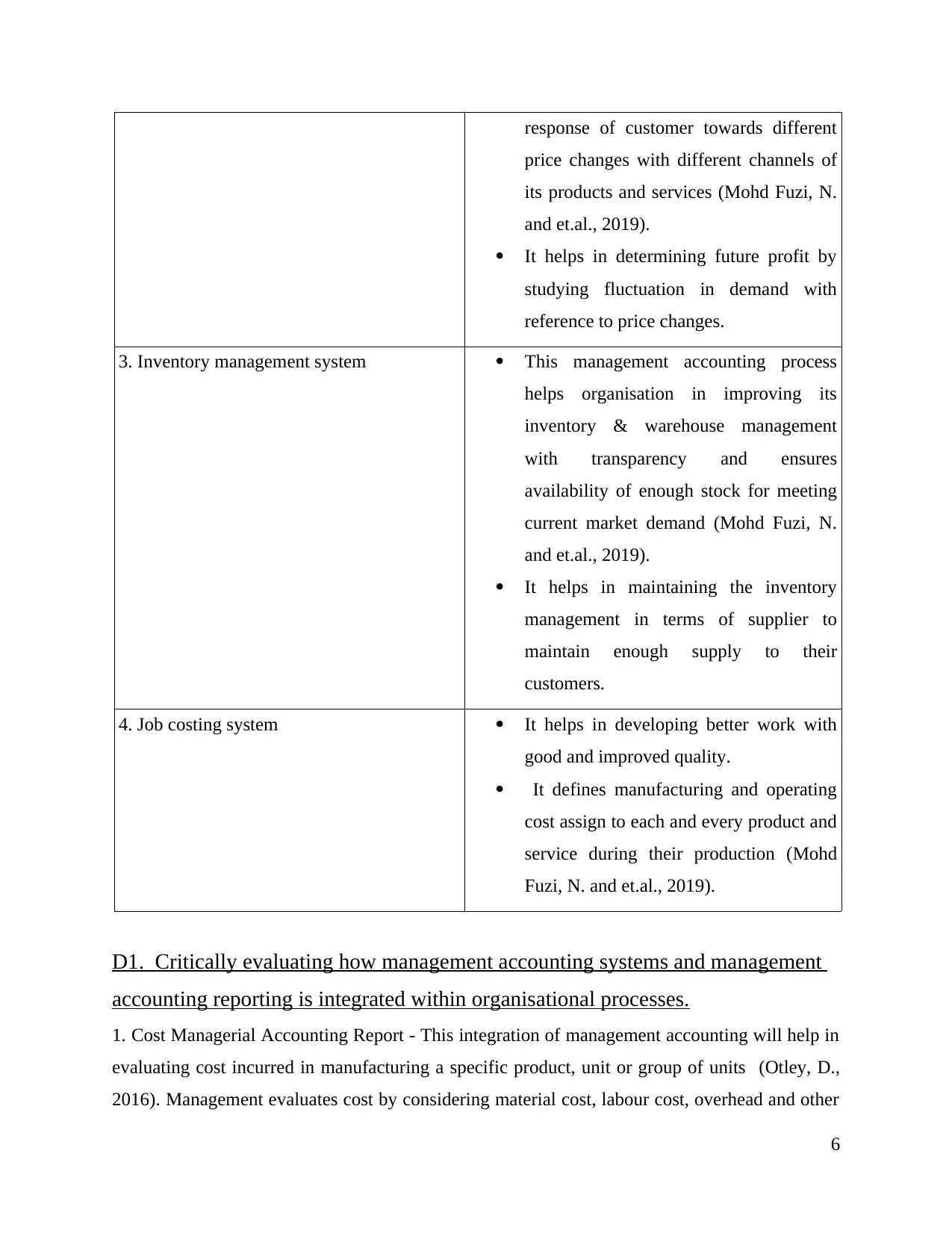
response of customer towards different
price changes with different channels of
its products and services (Mohd Fuzi, N.
and et.al., 2019).
It helps in determining future profit by
studying fluctuation in demand with
reference to price changes.
3. Inventory management system This management accounting process
helps organisation in improving its
inventory & warehouse management
with transparency and ensures
availability of enough stock for meeting
current market demand (Mohd Fuzi, N.
and et.al., 2019).
It helps in maintaining the inventory
management in terms of supplier to
maintain enough supply to their
customers.
4. Job costing system It helps in developing better work with
good and improved quality.
It defines manufacturing and operating
cost assign to each and every product and
service during their production (Mohd
Fuzi, N. and et.al., 2019).
D1. Critically evaluating how management accounting systems and management
accounting reporting is integrated within organisational processes.
1. Cost Managerial Accounting Report - This integration of management accounting will help in
evaluating cost incurred in manufacturing a specific product, unit or group of units (Otley, D.,
2016). Management evaluates cost by considering material cost, labour cost, overhead and other
6
price changes with different channels of
its products and services (Mohd Fuzi, N.
and et.al., 2019).
It helps in determining future profit by
studying fluctuation in demand with
reference to price changes.
3. Inventory management system This management accounting process
helps organisation in improving its
inventory & warehouse management
with transparency and ensures
availability of enough stock for meeting
current market demand (Mohd Fuzi, N.
and et.al., 2019).
It helps in maintaining the inventory
management in terms of supplier to
maintain enough supply to their
customers.
4. Job costing system It helps in developing better work with
good and improved quality.
It defines manufacturing and operating
cost assign to each and every product and
service during their production (Mohd
Fuzi, N. and et.al., 2019).
D1. Critically evaluating how management accounting systems and management
accounting reporting is integrated within organisational processes.
1. Cost Managerial Accounting Report - This integration of management accounting will help in
evaluating cost incurred in manufacturing a specific product, unit or group of units (Otley, D.,
2016). Management evaluates cost by considering material cost, labour cost, overhead and other
6
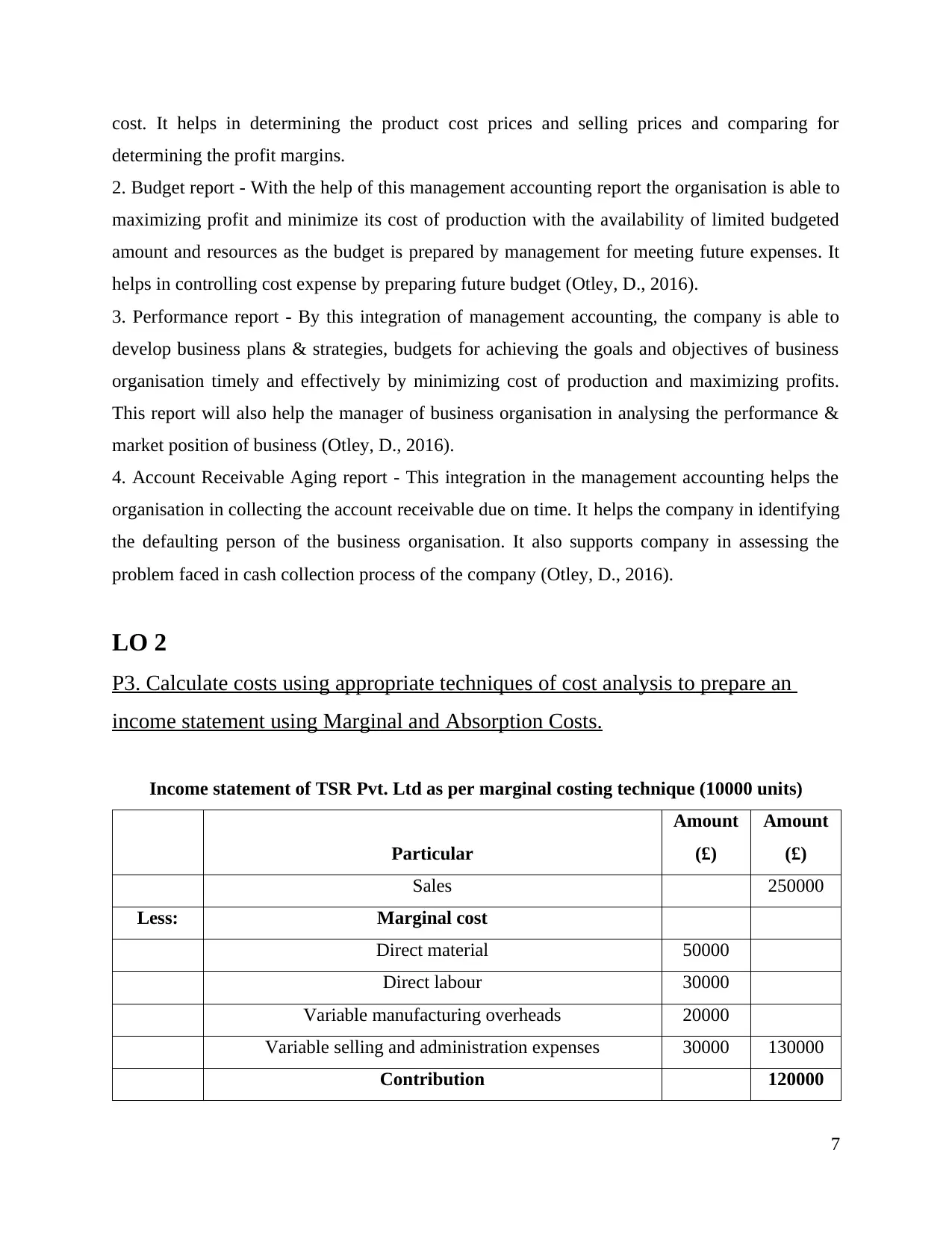
cost. It helps in determining the product cost prices and selling prices and comparing for
determining the profit margins.
2. Budget report - With the help of this management accounting report the organisation is able to
maximizing profit and minimize its cost of production with the availability of limited budgeted
amount and resources as the budget is prepared by management for meeting future expenses. It
helps in controlling cost expense by preparing future budget (Otley, D., 2016).
3. Performance report - By this integration of management accounting, the company is able to
develop business plans & strategies, budgets for achieving the goals and objectives of business
organisation timely and effectively by minimizing cost of production and maximizing profits.
This report will also help the manager of business organisation in analysing the performance &
market position of business (Otley, D., 2016).
4. Account Receivable Aging report - This integration in the management accounting helps the
organisation in collecting the account receivable due on time. It helps the company in identifying
the defaulting person of the business organisation. It also supports company in assessing the
problem faced in cash collection process of the company (Otley, D., 2016).
LO 2
P3. Calculate costs using appropriate techniques of cost analysis to prepare an
income statement using Marginal and Absorption Costs.
Income statement of TSR Pvt. Ltd as per marginal costing technique (10000 units)
Particular
Amount
(£)
Amount
(£)
Sales 250000
Less: Marginal cost
Direct material 50000
Direct labour 30000
Variable manufacturing overheads 20000
Variable selling and administration expenses 30000 130000
Contribution 120000
7
determining the profit margins.
2. Budget report - With the help of this management accounting report the organisation is able to
maximizing profit and minimize its cost of production with the availability of limited budgeted
amount and resources as the budget is prepared by management for meeting future expenses. It
helps in controlling cost expense by preparing future budget (Otley, D., 2016).
3. Performance report - By this integration of management accounting, the company is able to
develop business plans & strategies, budgets for achieving the goals and objectives of business
organisation timely and effectively by minimizing cost of production and maximizing profits.
This report will also help the manager of business organisation in analysing the performance &
market position of business (Otley, D., 2016).
4. Account Receivable Aging report - This integration in the management accounting helps the
organisation in collecting the account receivable due on time. It helps the company in identifying
the defaulting person of the business organisation. It also supports company in assessing the
problem faced in cash collection process of the company (Otley, D., 2016).
LO 2
P3. Calculate costs using appropriate techniques of cost analysis to prepare an
income statement using Marginal and Absorption Costs.
Income statement of TSR Pvt. Ltd as per marginal costing technique (10000 units)
Particular
Amount
(£)
Amount
(£)
Sales 250000
Less: Marginal cost
Direct material 50000
Direct labour 30000
Variable manufacturing overheads 20000
Variable selling and administration expenses 30000 130000
Contribution 120000
7
⊘ This is a preview!⊘
Do you want full access?
Subscribe today to unlock all pages.

Trusted by 1+ million students worldwide
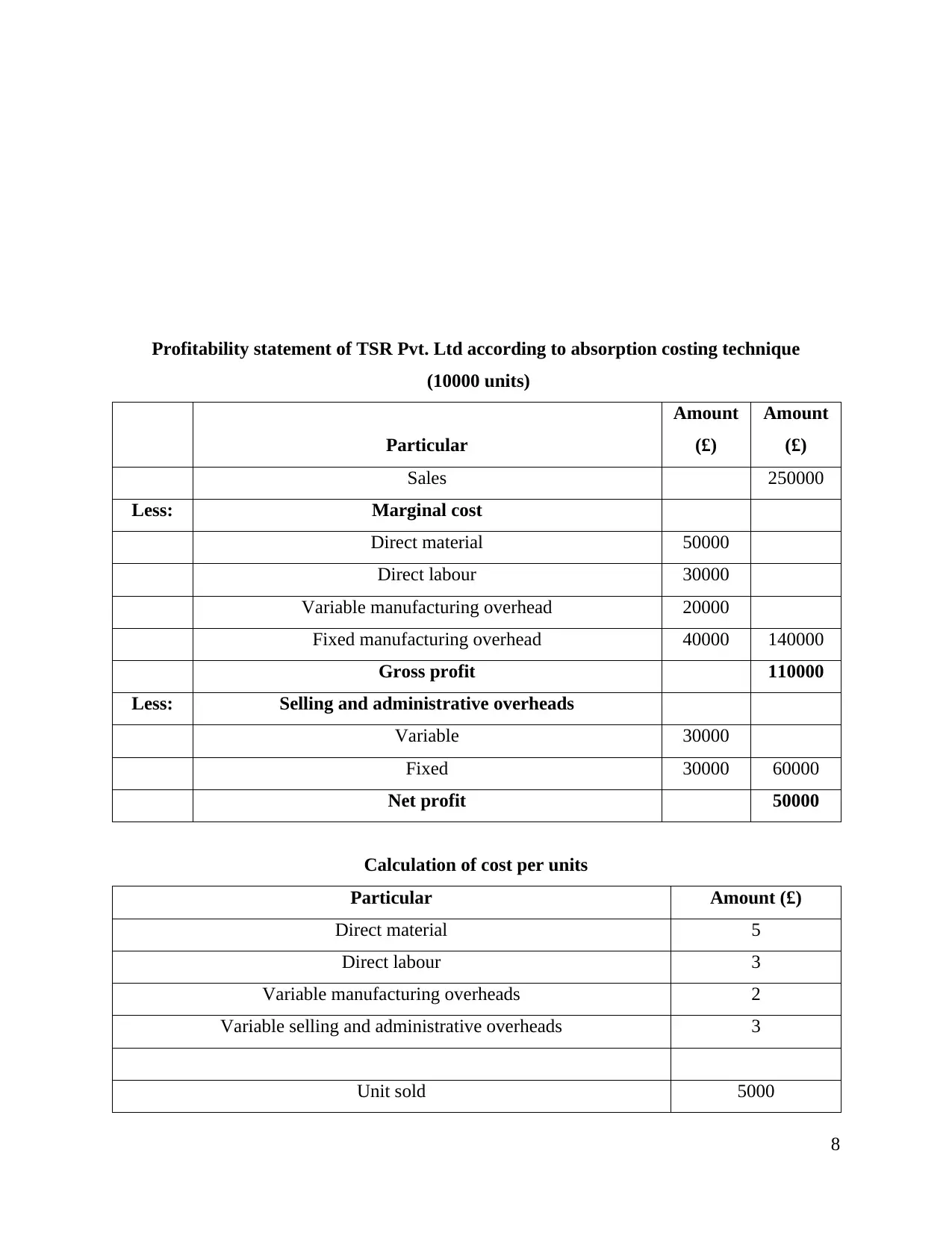
Profitability statement of TSR Pvt. Ltd according to absorption costing technique
(10000 units)
Particular
Amount
(£)
Amount
(£)
Sales 250000
Less: Marginal cost
Direct material 50000
Direct labour 30000
Variable manufacturing overhead 20000
Fixed manufacturing overhead 40000 140000
Gross profit 110000
Less: Selling and administrative overheads
Variable 30000
Fixed 30000 60000
Net profit 50000
Calculation of cost per units
Particular Amount (£)
Direct material 5
Direct labour 3
Variable manufacturing overheads 2
Variable selling and administrative overheads 3
Unit sold 5000
8
(10000 units)
Particular
Amount
(£)
Amount
(£)
Sales 250000
Less: Marginal cost
Direct material 50000
Direct labour 30000
Variable manufacturing overhead 20000
Fixed manufacturing overhead 40000 140000
Gross profit 110000
Less: Selling and administrative overheads
Variable 30000
Fixed 30000 60000
Net profit 50000
Calculation of cost per units
Particular Amount (£)
Direct material 5
Direct labour 3
Variable manufacturing overheads 2
Variable selling and administrative overheads 3
Unit sold 5000
8
Paraphrase This Document
Need a fresh take? Get an instant paraphrase of this document with our AI Paraphraser
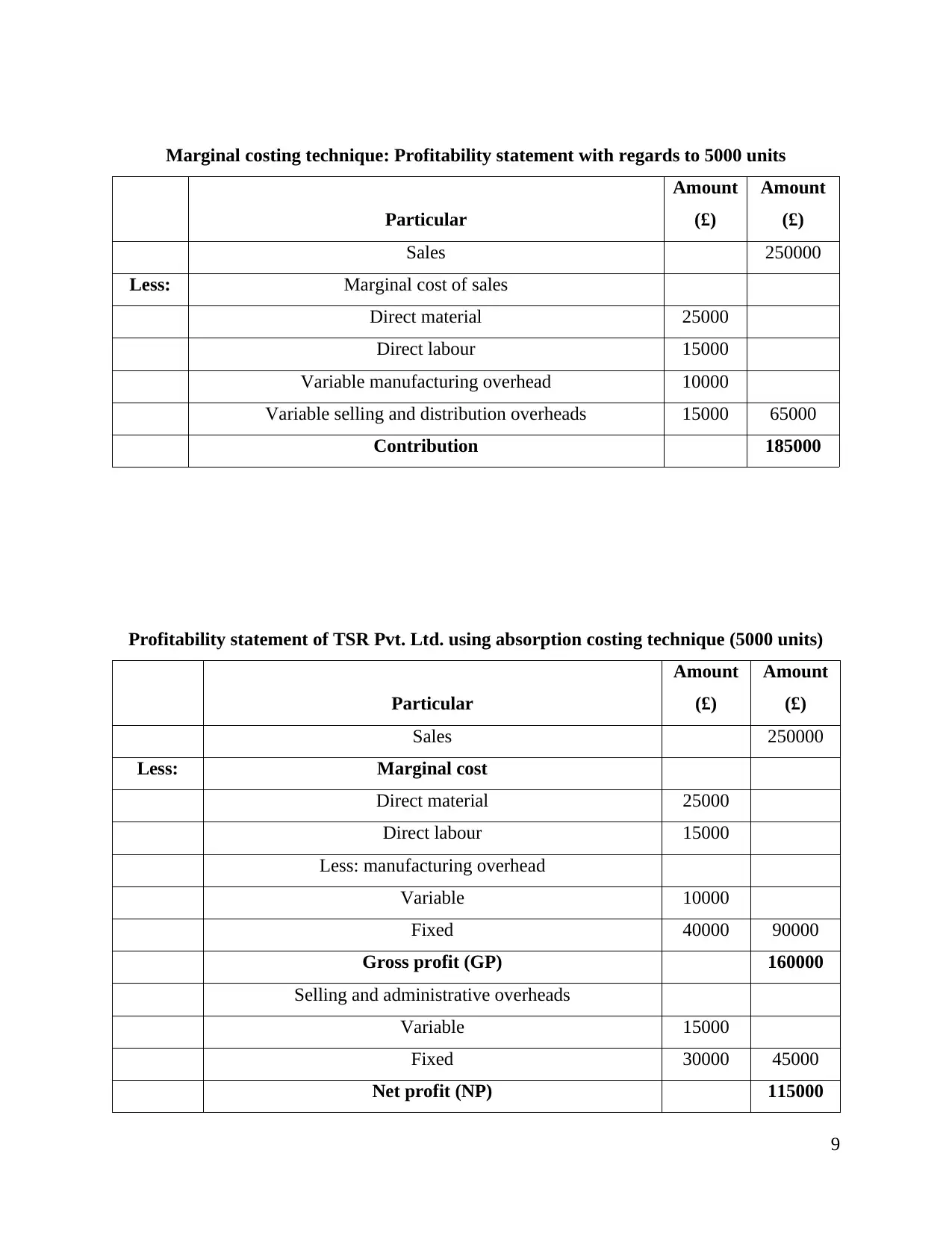
Marginal costing technique: Profitability statement with regards to 5000 units
Particular
Amount
(£)
Amount
(£)
Sales 250000
Less: Marginal cost of sales
Direct material 25000
Direct labour 15000
Variable manufacturing overhead 10000
Variable selling and distribution overheads 15000 65000
Contribution 185000
Profitability statement of TSR Pvt. Ltd. using absorption costing technique (5000 units)
Particular
Amount
(£)
Amount
(£)
Sales 250000
Less: Marginal cost
Direct material 25000
Direct labour 15000
Less: manufacturing overhead
Variable 10000
Fixed 40000 90000
Gross profit (GP) 160000
Selling and administrative overheads
Variable 15000
Fixed 30000 45000
Net profit (NP) 115000
9
Particular
Amount
(£)
Amount
(£)
Sales 250000
Less: Marginal cost of sales
Direct material 25000
Direct labour 15000
Variable manufacturing overhead 10000
Variable selling and distribution overheads 15000 65000
Contribution 185000
Profitability statement of TSR Pvt. Ltd. using absorption costing technique (5000 units)
Particular
Amount
(£)
Amount
(£)
Sales 250000
Less: Marginal cost
Direct material 25000
Direct labour 15000
Less: manufacturing overhead
Variable 10000
Fixed 40000 90000
Gross profit (GP) 160000
Selling and administrative overheads
Variable 15000
Fixed 30000 45000
Net profit (NP) 115000
9
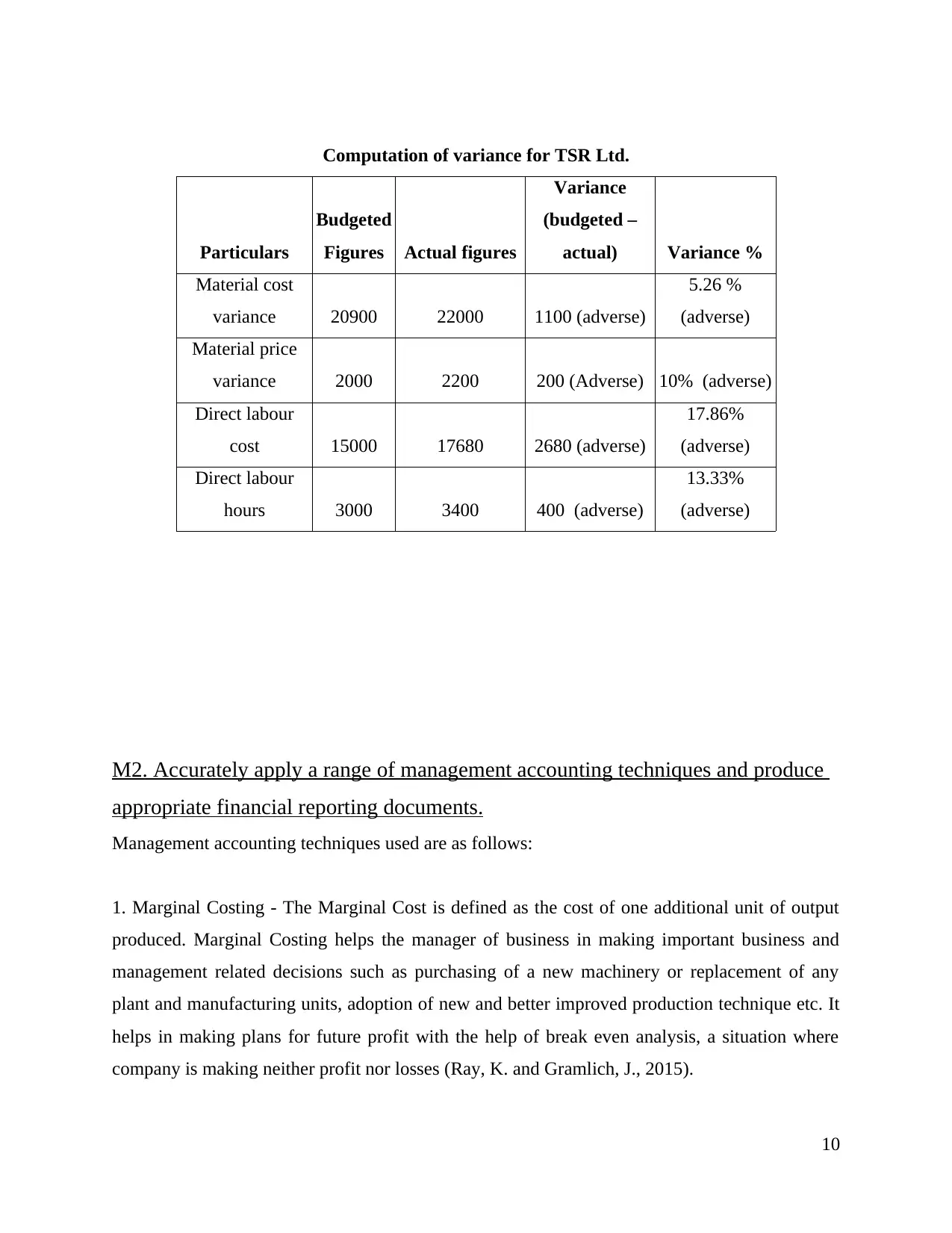
Computation of variance for TSR Ltd.
Particulars
Budgeted
Figures Actual figures
Variance
(budgeted –
actual) Variance %
Material cost
variance 20900 22000 1100 (adverse)
5.26 %
(adverse)
Material price
variance 2000 2200 200 (Adverse) 10% (adverse)
Direct labour
cost 15000 17680 2680 (adverse)
17.86%
(adverse)
Direct labour
hours 3000 3400 400 (adverse)
13.33%
(adverse)
M2. Accurately apply a range of management accounting techniques and produce
appropriate financial reporting documents.
Management accounting techniques used are as follows:
1. Marginal Costing - The Marginal Cost is defined as the cost of one additional unit of output
produced. Marginal Costing helps the manager of business in making important business and
management related decisions such as purchasing of a new machinery or replacement of any
plant and manufacturing units, adoption of new and better improved production technique etc. It
helps in making plans for future profit with the help of break even analysis, a situation where
company is making neither profit nor losses (Ray, K. and Gramlich, J., 2015).
10
Particulars
Budgeted
Figures Actual figures
Variance
(budgeted –
actual) Variance %
Material cost
variance 20900 22000 1100 (adverse)
5.26 %
(adverse)
Material price
variance 2000 2200 200 (Adverse) 10% (adverse)
Direct labour
cost 15000 17680 2680 (adverse)
17.86%
(adverse)
Direct labour
hours 3000 3400 400 (adverse)
13.33%
(adverse)
M2. Accurately apply a range of management accounting techniques and produce
appropriate financial reporting documents.
Management accounting techniques used are as follows:
1. Marginal Costing - The Marginal Cost is defined as the cost of one additional unit of output
produced. Marginal Costing helps the manager of business in making important business and
management related decisions such as purchasing of a new machinery or replacement of any
plant and manufacturing units, adoption of new and better improved production technique etc. It
helps in making plans for future profit with the help of break even analysis, a situation where
company is making neither profit nor losses (Ray, K. and Gramlich, J., 2015).
10
⊘ This is a preview!⊘
Do you want full access?
Subscribe today to unlock all pages.

Trusted by 1+ million students worldwide
1 out of 21